Driving in France can be a thoroughly enjoyable way to see the sights, without the time constraints of guided tours. However, it can also be quite a daunting task for those not familiar with France’s driving requirements. This includes driving on the right-hand side of the road and contending with new road signs, markings, and rules.
That is why it is always important to do your research on your destination’s laws and rules ahead of time.
For added peace of mind, you could also take out a standalone car hire excess insurance policy. Our hire car cover will cover any accidental damage caused to your vehicle, so you can continue to enjoy a stress-free holiday.
To help you navigate the French roads safely, we have put together a handy guide that covers all you need to know about French road signs, road markings and toll roads.
French Road Signs
Just like in the UK, you can usually get a good understanding of what road signs mean by their shape and colour. You may recognise some of the signs, as their meaning is universal.
Here is a general guideline for French road signs:
- Circular signs are regulatory signs that indicate the obligations and laws of a certain section of road, e.g. prohibiting overtaking
- Square signs are information signs that provide you with general information about the road, e.g. if there is a bend ahead
- Red and white triangular signs are warning signs advising you of potential hazards, e.g. children crossing
- Red and yellow triangular signs are temporary warning signs alerting you to hazards, e.g. road works
However, it is important to never assume that the road signs abroad will be the same as what you are used to, as some can differ greatly. Failing to do your research can put you and other road users at risk, with GOV.UK stating that 31% of Brits have driven on the wrong side of the road, while 44% have found themselves lost when abroad.
To avoid these dangerous errors and more, make sure you take the time to thoroughly research French road signs and their meanings ahead of your trip. Otherwise, you may receive a hefty fine for not adhering to the rules.
What are the essential French road signs to know?
Now that we have established the basics and importance of understanding road signs, it is time to delve deeper into what they actually mean.
While you may notice that some of the signs are the same, or very similar to what you are used to in the UK, it is important to remember that they may still have differences and should be thoroughly checked before you take to the road.
| Give way or ‘yield’ | Junction ahead – your right of way | Priority road |
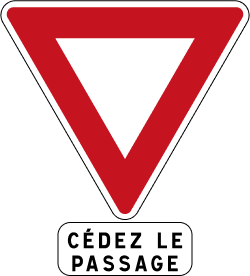 |  | 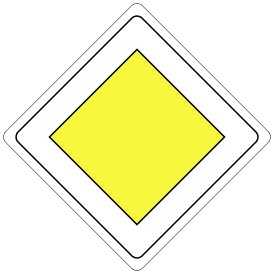 |
| You will usually see this sign when you are approaching a junction, as it indicates that you will need to give way to traffic. The sign will usually feature the phrase ‘Cédez le passage’ or a number that indicates the distance remaining until you reach the junction. | The above sign is within the warning category, but rather than alerting you of a hazard, it is making you aware that there is a junction ahead and you have priority. This means that drivers turning into the road or crossing your path should give way. However, as with driving in the UK, it is always important to never assume that another car will stop just because a sign indicates it. Always ensure that other cars have come to a complete stop before moving off again. | You may or may not be familiar with the French phrase ‘priorité à droite’, which means you must give way to traffic coming from your right. However, this does not apply at all times, and in particular on ‘priority roads. If you see a French road sign with a yellow diamond and a white edge, this means you are entering a priority road and that you have the right of way. This means that vehicles coming in from the right must give way to you in this instance. However, when you see the priority road sign with a black line struck through it, this means that this is the end of a priority road, and normal rules resume. |
| Priority on a turn | Stop | No entry |
 | 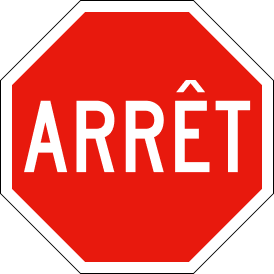 | 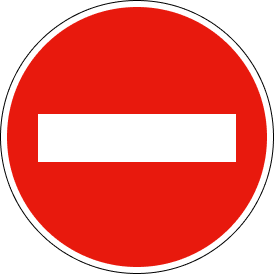 |
| When driving in France, you are likely to see these signs before you reach a junction, as they indicate who has priority when making a turn. The sign above illustrates that any driver turning right has the priority. However, it is important to pay close attention, as these signs can vary, depending on who has priority at that particular junction. | French stop signs are easily recognisable, as they are very similar to their UK counterparts. The only difference is that instead of ‘stop’ you will see the word ‘arrêt’. Just like in the UK, you must come to a complete stop at this sign; otherwise, you could face a fine of up to €135 and four points on your license. | Similarly, the French road sign for ‘no entry’ looks and means exactly the same as it does in the UK. This sign indicates that entry to that specific area or section of road is prohibited, so you will need to find an alternative route. |
| Speed limit | End of speed limit restrictions | Roundabout |
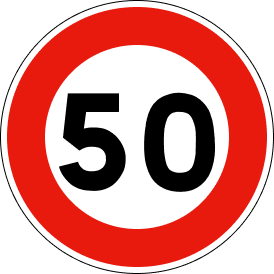 |  |  |
| Other signs that are very similar to the ones you may be used to in the UK are those for speed limits. The only key difference is that much like other European countries, France follows the metric system for speed limits and distances. So, rather than 50 mph, you would see 80 kph when driving through built-up areas. If you see ‘rappel’ on a French road sign, this is a reminder that the speed restrictions are still in place. | This sign tells you that you have reached the end of the zone with this required speed limit. So, that particular speed limit no longer applies; however, that does not mean there aren’t still limits in place. Always look out for signs that alert you to a new speed limit, although, if there isn’t one, you would need to follow the general guideline for French speed limits. | One of the most common priority signs you will see in France is for roundabouts. In France, you are expected to give way to traffic that is already on the roundabout or about to join from your left. An important rule to remember is that French roundabouts operate in an anticlockwise direction, the opposite of the UK. While they may seem daunting at first, French roundabouts will soon become second nature as you use them more frequently. |
| Restricted driving zone | Accident ahead | Turn lights on/off |
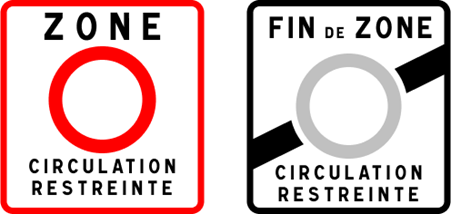 | 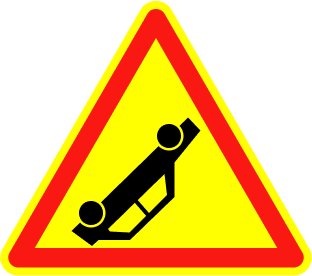 | 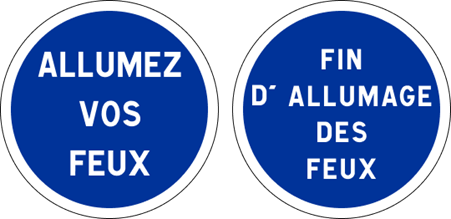  |
| Much like some of the cities in the UK, France has introduced low-emission zones in some of theirs. Low-emission zones are referred to as ‘zone à circulation restreinte’, and signs will indicate where they start and end. Before heading out for the day, it is always best to research where the low-emission zones are in France. To drive in these areas, you must have a ‘Crit’air’ (clean air sticker) clearly displayed on your windscreen. If you fail to display the sticker while driving in one of these zones, you could be issued a fine of up to €180. | If you see one of these temporary French road signs, it means that there is an accident ahead. It is alerting you to the fact that the road is blocked and that there may be significant delays. | You will often see the sign stating ‘allumez vos feux’ when you are entering an area where driving with dipped headlights is mandatory at all times. French law requires that all cars be fitted with headlight beam deflectors, unless lights can be adjusted manually, to avoid dazzling other road users. When you reach the end of one of these areas, this will be marked by a sign with the words ‘fin d’allumage des feux,’ meaning turn off your lights. |
| No parking | Toll booth ahead |
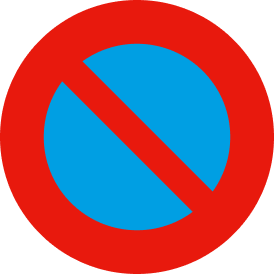 | 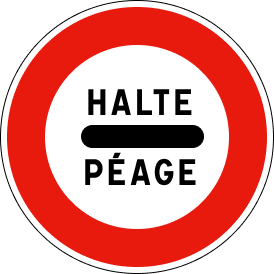 |
| Before going out to explore, it is always worth doing your research on where you can and cannot park in the area. No parking zones can be easily identified and are often found in areas such as loading zones, bus stops, and schools. If you are caught parking illegally in France, you could be issued a fine or have your hire car clamped and impounded. | Much like in Italy and Spain, toll roads are very common in France. When you see the sign ‘halte peage’, this indicates that you need to slow down as you are approaching a toll booth, where you will need to pay in order to drive along French a roads. |
French Road Markings
While you are learning more about the country’s road signs and their meanings, it is also important to think about French road markings. Just like the signs, some of the road markings share many similarities with those in the UK.
However, some can differ in how they are used, so it is always best to do some extra research.
Here is a general guideline for French road markings:
- Solid white line – Indicates the edge of a road or lane that drivers are prohibited from crossing
- Broken white line – Used to break up lanes of traffic. Drivers may cross these lines when it is safe to do so
- Solid yellow line – Often in a zig-zag pattern, it signifies that both parking and stopping are forbidden
- Broken yellow line – Indicates you may stop to load or unload, but you must not park
It is also important to look out for road markings that are only for the use of certain vehicles, such as buses, bikes, and taxis.
These are usually highlighted by symbols of the vehicles painted on the road, signs stating who the lane can be used by, and can be painted in a different colour to distinguish from other lanes.
Driving in the incorrect lane is a sure-fire way of getting yourself a fine of up to 135, so it is always best to be aware of your surroundings.
Toll Roads in France
While you may have come across a toll road or two in the UK, France is home to over 90 of these roads, so it is worth doing some extra research on them before your trip.
You now know that you can easily recognise when you are approaching a toll booth by the sign ‘halt peage’, but you can also spot toll roads by looking for signs marked by the letter ‘A’ for autoroute, followed by a series of numbers.
How do you pay on French toll roads?
While the prospect of navigating your way through French toll roads might seem intimidating, it really couldnt be simpler.
You will find manned and unmanned toll booths across the country. However, if you would prefer a manned booth, these can easily be identified by a sign of a person in a cap above the lane.
Toll booths in France will usually accept payment via credit, debit card, or cash.
If you don’t want to waste time queuing to pay, you can always opt to use an electric toll tag system. Using a French toll road tag from Telepass or Emovis allows you to fit the device to your car, connect your card to your tag, and drive through the automated toll lanes, bypassing the need to stop and pay.
How much do toll roads in France cost?
The price you will pay to access a toll road in France can vary depending on the type and weight of the vehicle you are driving. These are divided into five categories:
- Category 1 – Cars less than two metres and under 5.5 tonne
- Category 2 – Vehicles between two and three metres and under 5.5 tonnes
- Category 3 – Can have a trailer but must both have a combined weight of 3.5 tonnes and a height of over three metres.
- Category 4 – Must weigh more than 3.5 tonnes and have a height of more than four metres. This can include vehicles such as HGVs and trucks.
- Category 5 – Motorcycles which can have a sidecar
Before heading out for the day, you can check where the toll roads are in France, so you can be prepared.
Final Thoughts
France is a beautiful country with plenty to see and do. However, by not having all the information you need, you may be reluctant to explore as much as you would like to.
By gaining a greater understanding of French road signs, markings, and toll roads, you can feel more confident when driving on the road, safe in the knowledge that you have everything you need to enjoy a memorable trip.




Comments are closed